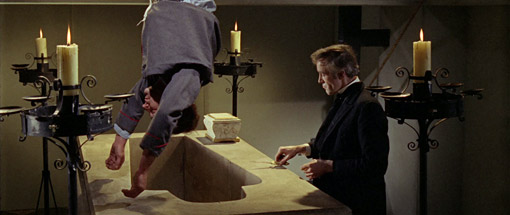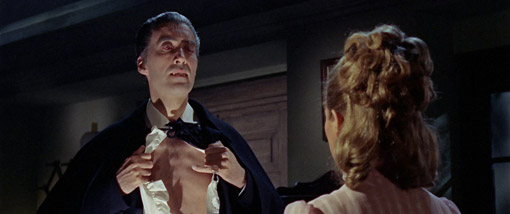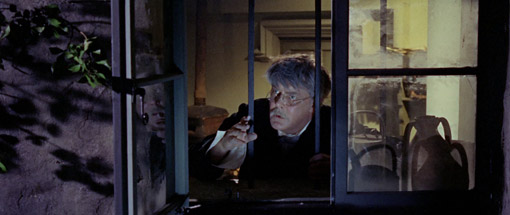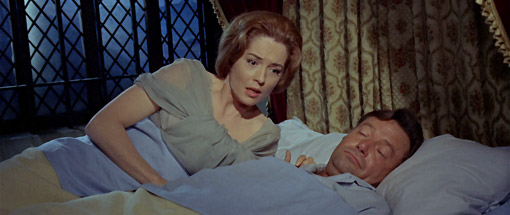| |
"Not kill. He is already dead. He is undead Mr. Kent. He can be destroyed, but not killed." |
| |
Father Sandor outlines the nature of their foe
to naïve English traveller Charles Kent |
Depending on how you approach it, Dracula Prince of Darkness* is either the second or the third film in Hammer's Dracula series. As a direct follow-on to the studio's phenomenally successful Dracula (aka The Horror of Dracula if you live in the States), it's logically the second, but between these two films came The Brides of Dracula, which although reprised Peter Cushing's role as Van Helsing, is a film in which Dracula neither appears nor gets a mention. Thus despite the use of the Count's name in the title, Brides of Dracula is a Hammer vampire movie rather than a Hammer Dracula movie, a separate strand that was thematically continued in 1963 with The Kiss of the Vampire.
From its opening frames, Dracula Prince of Darkness established itself as the true sequel to Dracula with a pre-title sequence that reprises that film's dynamic finale, a kind of "previously on Dracula" prologue for a cinema audience who would likely be in need a quick refresher, given the eight year gap between the two films. And the film does rely on you knowing what went before to appreciate just why a party of upbeat English travellers are solemnly advised to steer clear of Karlsbad, why members of a village funeral cortege attempt to hammer a stake into a dead girl's chest, and why a forthright monk named Father Sandor loudly mocks the actions of the superstitious locals. Ah, Father Sandor. I'll be coming back to him.
The four travellers in question are young couple Charles and Diana (I kid you not), who are accompanied by Charles' older brother Alan and his wife Helen, who are all English, middle-class, and know nothing of the local history or traditions. A few drinks at the inn and a friendly chat with Father Sandor and they're on their way to Karlsbad, in spite of Sandor's advice to give it a wide berth. They don't get far. Having agreed to transport them, their driver suddenly brings their coach to a halt and refuses to go any further. When Charles objects, the man punches him in the mouth, throws their luggage to the ground and speeds off in the direction from whence they came.

Faced with the prospect of spending the night in a run-down roadside shack, they are surprised and a little relieved when another coach appears, albeit one bereft of a driver. They think it a little strange, at least all except Alan. "Haven't you heard?" he quips, "Never look a gift horse in the mouth" (it's a horse-drawn carriage if you're having trouble with that one), and despite Helen's reluctance they all jump on board with the intention of driving the coach on to Karlsbad. The horses, however, have other ideas and make a bee-line to the courtyard of a nearby castle, one their grumpy ex-driver refused to acknowledge the existence of and is not marked on their map. We, of course, know just where this is, but of this foolhardy quartet only the ever-uncertain Helen has any reservations. Inside they find the dinner table set for four guests, and when Charles looks upstairs he finds their luggage has been brought in and their beds have been readied. What, they wonder, is going on here? Answers arrive in the shape of manservant Clove (I'll be coming back to him, too), a polite but still sinister individual who reveals that his master – a certain Count Dracula – is no longer with us, but left instructions that the castle be always ready to receive guests, presumably in the hope that some unwary foreign travellers would one day wander off the beaten track. Today, it would seem, is the Count's lucky day.
Before I go on I should probably lay my cards on the genre table. While I'm perfectly aware that Hammer's 1957 Dracula deviated considerably from Bram Stoker's celebrated source novel, it remains for this horror fan second only to F.W. Murnau's superb Nosferatu as the finest of all cinematic interpretations of the Dracula story. The two lead players were divinely cast, familiar story elements deliciously usurped (Harker turns out not be the innocent of the novel but working with Van Helsing to kill Dracula from the start) and the climactic confrontation is one of the most thrilling handled in horror film history. And it was directed by Terence Fisher, now widely recognised as one of this country's finest and most important genre filmmakers, and the man behind a number of Hammer's most highly regarded films, including The Curse of Frankenstein, The Mummy, The Brides of Dracula, The Devil Rides Out, and, of course, Dracula Prince of Darkness.
It's Fisher's brisk handling of action and dialogue here that keeps the extended build-up both intriguing and credible, and it's his talent for capturing the inherent eeriness of gothic locations that invests the proceedings with a real sense of menace, despite the fact that no specific threat has been defined. This is most evident when the group retire to their rooms to settle down for the night and the camera prowls the corridors in search of a victim, the wind howls in the distance, and Helen ominously predicts that "there'll be no tomorrow for us." And at a time when horror movie characters are often dumb by default, it's refreshing to look back at a film where bad decisions are made for plausible reasons – Alan and Charles dismiss Helen's concerns not out of bull-headed ignorance but because she's seen as a perennial complainer and they've heard it all before, while their seeming willingness to place themselves in peril is largely down to the fact that, as members of the privileged classes, they've little experience of real danger to draw on.

With Dracula destroyed and reduced to dust even before the film starts, there's a building anticipation about how he will return, and given that Christopher Lee is given star billing here and is all over the poster, we know that he will. The process of his reanimation is triggered by one of the nastiest sequences in any Hammer film (a man is hung upside down and his throat slit by Clove with the cold detachment of a slaughterhouse worker butchering a pig) and gives rise to one of their most impressive effects, a series of sometimes invisible dissolves in which the Count's body reforms in sequential layers of bone, muscles, blood vessels and tissue, concluding with a hand that crawls out of the sarcophagus like a predatory spider.
The subsequent blend of plot twists and action is in many ways typical of the determination of Hammer scriptwriting stalwarts Jimmy Sangster and Anthony Hinds** to re-enforce and build on established vampire lore and their own previous genre outings. The improvised cross and the suggestion that you could burn out the effects of a fresh vampire bite from Dracula and Brides of Dracula respectively are recycled here, while the news that a vampire can be destroyed by running water and cannot enter a domain unless invited in are given an early cinematic outing. The sexual overtones of the vampire attack are also taken a step further here in the transformed Helen's vampiric wooing of Diana and the scene in which the Count bares his chest, opens a vein and draws the hypnotised Diana towards him to drink his blood, a sequence that plays like a prelude to forced fellatio.
Like so many film franchises, Hammer's Dracula series fell victim to the law of diminishing returns, with the quality dropping as the series progressed. It's generally agreed that the decision to transport the Count into swinging London in Dracula AD 1972 was the kiss of death, though by then the studio was also falling victim to changing times and tastes, their old-school horror proving no match for the urban terrors of Rosemary's Baby and Night of the Living Dead. But in 1966 the studio still held sway, and Dracula Prince of Darkness saw them on stonking form. The actors may retrospectively mock aspects of Hinds and Sangster's script,*** but there's an economically frills-free approach to storytelling and dialogue echoed in Fisher's taut direction and some solid performances (lead players Francis Matthews, Barbara Shelley, Suzan Farmer and Charles Tingwell are all first rate), one that brings even the most humdrum of exchanges to life and keeps the drama and horror organically bonded. An air of brooding menace is created by Michael Reed's Techniscope cinematography and interior lighting, and regular composer James Bernard recycles the iconic name-calling theme from Dracula and accelerates the chases with galloping brass and drums.

But what really gives Dracula Prince of Darkness it's distinctive identity are three supporting characters that remained unique to this one film, each equally memorable in their own sweet way. In the absence of Van Helsing, Father Sandor proves an imposing substitute, an action-man monk with the wisdom to know how to prepare for battle and the physical strength to carry it through. Played with no-nonsense authority by studio regular Andrew Keir (who the following year would be cast as the best movie Quatermass in Quatermass and the Pit), Sandor is the sort of holy man who would convert you to Christianity by slapping you round the head and sticking a rifle up your hooter, a weapon he carries with him to add weight to his words and reinforce his contempt for the nervous locals. He also gets some of the film's best lines, assuring the travellers as he warms himself by the fire that "my calling still allows me the comfort of a warm posterior...one of the few pleasures left in life," and berating a local priest by telling him loudly, "You are an idiot, father. Worse than that, you are a superstitious, frightened idiot." Equally memorable is Philip Latham's deliciously sinister turn as Dracula's manservant and protector Clove. Latham walks a fine line here between menace and theatrical camp and gets it absolutely right, his polite delivery given a menacing edge by his posture, expression and suggestive inflection. In one of my favourite moments of unspecified threat, Alan answers a knock at his bedroom door to find Clove filling the door frame and holding a candle snuffer in a manner that suggests it could double as a dark wizard's wand, an offensive weapon, or an instrument of torture. Completing this delightful trio is Thorley Walters' engaging turn as gentle madman Ludwig, an unexpectedly faithful stand-in for the novel's Renfield, right down to his sensitivity to the telepathic callings of his adopted master and his fondness for catching and consuming flies.
There are doubtless those even within the realms of horror fandom for whom Hammer films feel dated, formulaic and just a little bit camp. Frankly it's their loss. In the documentary on this disc, Hammer biographer Marcus Hearn claims that while not one of the studio's very best, Dracula Prince of Darkness is in many ways the quintessential Hammer horror, containing as it does so many of the elements that typified the studio's genre works, only lacking the presence of Peter Cushing to make it complete. Either way, it's a terrific entry into a series that this very film's commercial success was instrumental in reviving, and one of the most fondly regarded works of Hammer's mid-60s period.
Shot in Techniscope, a process that produces a 2.35:1 picture by using only half of the standard 35mm frame, the film was restored at Pinewood from a somewhat grainy negative, one that required the manual removal of spice marks on every edit. The restoration team also had to adjust the aspect ratio of the opening recap, and re-composite the original British Hammer-Pathé titles from a severely damaged print. The results really are impressive, with a far greater level of detail than you'll find on any previous DVD or video version, a warm colour palette with sometimes vibrant though not over-saturated primes (most clearly visible in the redness of the blood and the luminance of the stain glass window in its upstairs corridor) and a finely balanced contrast range that brings detail to areas that were previously lost in shadow. The image is also very clean, with only the faintest traces of previous dust or damage. There does appear, however, to be one small oversight, one I'm happy to be corrected on if I've called this wrongly. As was once common practice, night-time exteriors were shot day-for-night,**** but here the requisite post-production adjustments in exposure and filtration appear not to have been made, resulting in a wide shot after Charles and Diana have made their escape in which Dracula seems to cross the castle grounds in daylight, somewhat mocking Father Sandor's claim that he can be destroyed by sunlight. Overall though, a serious improvement over previous video versions.

The faux 5.1 mix found on the 1998 US Anchor Bay DVD has been jettisoned here in favour of a more authentic PCM mono 2.0 track. The expected range restrictions aside, the dialogue is clear and even the loudest music is free of distortion. Unfortunately there is also a small glitch here. As the travellers are transported to the castle by the homing horses, the sound and picture go slightly out of sync and stay that way until the group enter the castle a few minutes later, an issue not present on the Anchor Bay DVD. I have to stress that I'm working from a review disc here and that this may have been sorted on the final release. It doesn't last long, but it's hard to ignore, particularly on a big TV and on a transfer where faces can be so clearly seen.
Several of the extra features here have been sourced from the aforementioned Anchor Bay DVD but that's no bad thing, as that remains one of the best featured DVDs of any Hammer work and it makes perfect sense to include its extras here.
Commentary
This is a real rarity for a Hammer film, a commentary featuring lead actors Christopher Lee, Suzan Farmer, Francis Matthews and Barbara Shelley, and it's a bit of a treat. All four clearly enjoyed working for Hammer and for director Terence Fisher, and have plenty of jovial recollections of the pleasures of the shoot and the occasional hardships, from Lee's glass contact lenses to Barbara Shelley's memory of swallowing a fang and then, with no spares available, having to retrieve it by forcing herself to vomit. Lee effectively holds court here and proves a captivating storyteller, ridiculing the decision to bring Dracula into a modern day setting in the later films and expressing his frustration at the failure of any film version of Dracula to be completely faithful to Stoker's novel. He does take a few entertaining diversions, including theatrical stories that have him impersonating John Gielgud and Noel Coward. All four seem to agree that making films is nowhere near as much fun as it used to be, particularly in America, where "nobody smiles," at least on a film set. Since this was imported from the Anchor Bay DVD, we can assume it was recorded in 1998.
Back to Black (29:34)
A newly shot retrospective documentary featuring genre historians Marcus Hearn and Jonathan Rigby, actor, writer and genre devotee Mark Gatiss, and actors Barbara Shelley and Francis Matthews, who collectively look back at the film's making and its position in Hammer's filmography. Special praise is directed at Terence Fisher, and Francis Matthews winces at a scene he believes contains his worst ever performance. But wait, there's more! James Bernard biographer David Huckvale provides a fascinating breakdown of the music score's key themes, and Pinewood's Technical Restoration Manager Jon Mann outlines the problems his team faced when restoring the film to its present condition.

World of Hammer (24:48)
An episode of the documentary series World of Hammer entitled Starring Christopher Lee, one comprised entirely of lengthy extracts from some of Lee's key films for the studio and narrated in his usual authoritative whisper by Oliver Reed. It's in very good shape and provides a useful intro to Lee's Hammer work for genre newcomers.
Behind the Scenes (4:39)
Another extra ported over from the Anchor Bay disc, this consists of 8mm footage recorded on the set of the shooting of the film's climactic scene by Francis Matthews' brother Paul Shelley, and features a commentary by actors Christopher Lee, Barbara Shelley, Suzan Farmer and Francis Matthews. Brief but interesting, though the second half is shot and cut like an alternative version of the scene it is observing.
Restoration Comparison (3:57)
While I salute the excellent work done by the Pinewood team in restoring the film to its present condition, I've seen enough restoration comparisons to seriously wonder about this one. Several sequences are shown before and after the restoration, sometimes side-by-side, and in every case the 'before' footage looks like the 'after' footage with the brightness cranked up and the contrast softened, and by the exact same amount in each example. Look carefully, though, and you'll spot examples of how much dirt and damage were removed in the clean-up, but the increased brightness here makes it harder to clearly see.
Trailer (2:22)
A dramatic sell with fabulously ominous voice-of-doom narration and lots of thunderclaps.
Double Bill Trailer (0:36)
The tackiest graphics you'll ever see on a Hammer trailer for a double-bill release of Dracula Prince of Darkness and Frankenstein Created Woman.
Also included are the Original USA Titles (0:24) and the original print of the UK Theatrical Titles (0:31), which are in a very poor state but were used by the restoration team to re-composite the correct UK release title sequence seen on this transfer.
Dracula Prince of Darkness was followed by Dracula Has Risen From the Grave (1968) – which I've always liked a lot – Taste the Blood of Dracula (1970), Scars of Dracula (1970), Dracula A.D. 1972 (erm, 1972) and The Satanic Rites of Dracula (1973), by when Christopher Lee had lost all faith in the direction the series had taken. Of the direct sequels to Dracula this remains the best, for its atmosphere and pace, its solid performances, its tightly structure script and its splendid supporting characters. The restoration is first rate and the extras gathered here really do the film proud. My only complaint is that day-for-night grading (which is hardly a deal breaker) and that brief but annoying sound sync issue. This still comes recommended, but would be more enthusiastically so if that sound slip was fixed.
* Although the IMDb lists the official title as Dracula: Prince of Darkness, with a colon after the Count's name, no such punctuation appears on the front title of the movie itself.
** The pair wrote here under the pseudonyms John Sansom and John Elder.
*** There has for some time been some disagreement over the reason that Dracula himself has no dialogue. Christopher Lee has asserted that this is because the lines he was given were so awful that he simply refused to say them. This was disputed by screenwriter Jimmy Sangster in his memoir Inside Hammer, where he claimed that he wrote no dialogue for the character in the first place. The truth has not been definitively confirmed either way, but the expert opinion does tend to favour Sangster's version, and it does make a degree of chronological sense, given that in the first film Dracula only speaks in the opening scenes, after which he reverts to a more animalistic means of vocal expression.
**** For those not familiar with the term, a little explanation is probably required. Exterior scenes that require a non-naturalistic look, particularly if the image is to be rendered darker than the daylight norm, would often be shot with the best possible exposure to maximise picture quality and then graded in post-production, where the light levels can be lowered and any required colour tint added. This gives filmmakers far greater flexibility than creating the effect in-camera, allowing them to carefully control the grading so that a fine balance between the required look and picture detail can be achieved and altered if needed. Modern digital grading allows an almost ludicrous level of image control, hence the current obsession with colouring and desaturating the look of films to the point where a realistic colour palette is the exciting exception. In pre-digital times this was achieved photo-chemically and/or at the printing stage, and a favourite for such treatment was what became known as Day for Night (which the French delightfully refer to as nuit américaine due to its common use in American westerns), a pragmatic process that involved shooting scenes in sunlight and then lowering the exposure and adding a (usually blue) colour tint in post-production to make the image appear as if it was actually shot at night. It never really did, but it did inform the audience that the scene was intended to be read as taking place at night, and only the most picky felt obliged to point out that the briefly glimpsed night sky seemed awfully blue. |